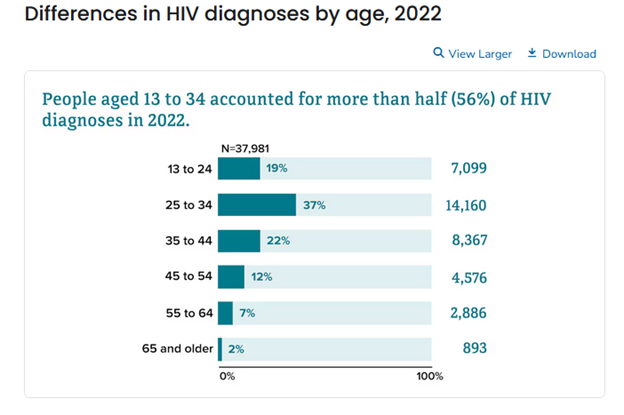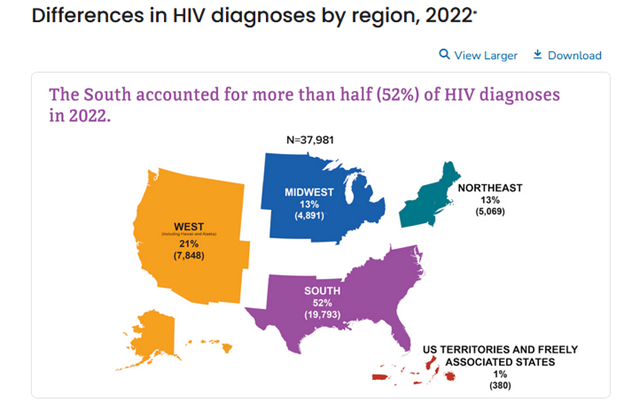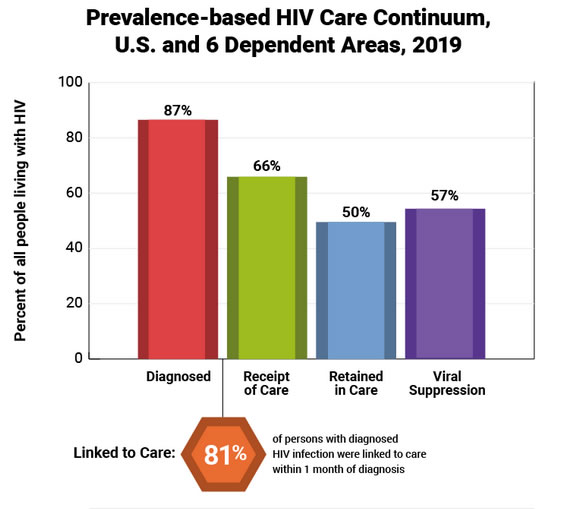Online Course
NRSG 780 - Health Promotion and Population Health
Module 11: Infectious Diseases
HIV/AIDs Prevalence and Prevention
The CDC estimates that approximately 1.2 million people are living with HIV infection in the U.S., 13% of whom (1 in 7) are unaware of their infection. During the last ten years, the number of people living with HIV has increased, while the annual number of new HIV infections has declined by 19% from 2005 to 2014 and has leveled off to approximately 35,000 new cases per year. In the U.S., HIV is spread mainly by having sex or by sharing injection drug-use equipment with an infected person.
As noted in the graph below, gay, bisexual and other men who have sex with men (MSM) are most seriously affected by HIV.

Source:https://www.hiv.gov/hiv-basics/overview/data-and-trends/statistics
Young people aged 13-24 account for more than 1 in 5 nearly 25% new HIV diagnoses or nearly 107,000 individuals.

Source: https://www.cdc.gov/hiv-data/nhss/hiv-diagnoses-deaths-prevalence.html
For additional information on trends in new HIV Diagnoses click on https://www.cdc.gov/hiv-data/nhss/hiv-diagnoses-deaths-prevalence.html
U.S. Geographic Distribution
Significant variations in the HIV and AIDS epidemic exist across the country. It is primarily concentrated in urban areas and higher rates were reported in the South.
Data from 2021 indicates that the incidence of HIV diagnoses remains highest in the South.

Source: https://www.cdc.gov/hiv-data/nhss/hiv-diagnoses-deaths-prevalence.html
Prevention
HIV is transmitted through blood, semen, pre-seminal fluid, rectal fluids, vaginal fluids and breast milk from an infected person. These fluids must come into contact with a mucous membrane or damaged tissue or be directly injected into the bloodstream for transmission to occur. Click here for more information on HIV transmission.
HIV can be prevented by avoiding exposure to the fluids that can transmit the virus through using condoms correctly and consistently, limiting the number of sexual partners, never sharing needles and through biomedical options such as pre-exposure and post-exposure prophylaxis. Click here for more information on HIV prevention.
Prevention efforts are challenged by the facts that of the 1.2 million Americans living with HIV:
- 1. approximately 13% are unaware of their serostatus and
- only 57% are virally suppressed.

Source: https://www.hiv.gov/federal-response/policies-issues/hiv-aids-care-continuum
To better understand the disparities in HIV prevention at all levels click on this video and review the required reading at http://aids.gov/federal-resources/policies/care-continuum/
Inroads have been made in advancing early treatment and routine testing for HIV. For more information review the CDC website for HIV testing available at https://www.cdc.gov/hiv/testing/.
Health care workers follow Universal Precautions for Preventing Transmission of Bloodborne Infections to prevent infection from HIV/AIDs. Click here for more information.
This website is maintained by the University of Maryland School of Nursing (UMSON) Office of Learning Technologies. The UMSON logo and all other contents of this website are the sole property of UMSON and may not be used for any purpose without prior written consent. Links to other websites do not constitute or imply an endorsement of those sites, their content, or their products and services. Please send comments, corrections, and link improvements to nrsonline@umaryland.edu.